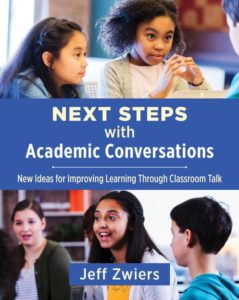Fresh Approaches to Academic Conversations
Next Steps with Academic Conversations: New Ideas for Improving Learning Through Classroom Talk
By Jeff Zwiers
(Stenhouse Publishers, 2019 – Learn more)

I was drawn to Jeff Zwiers’ book because the title promised me some new ideas to improve student learning through academic conversations, and because the title acknowledged what an academic conversation actually is or at least where it begins.
Academic conversation begins, foundationally, as classroom talk.

Academic conversations create lifelong learners – learners who believe they have a voice in the conversation of ideas across time. Zwiers’ book provides some new, novel, and effective means to equip teachers with the tools to promote academic conversations in their classrooms.
Getting students started with visual tools
One of the best features in this book is the inclusion of visual tools for students to use in the process of conversation. Zwiers offers Idea Building Cards that conversing students can use to construct dialogue and clarify meaning. These cards provide students with a visual building block that can help take them beyond the one liners. Even if they get stuck, the visual cards give them the tool they need to probe deeper.
Examples are given across various subjects, from Math and Science to Literature and History. Information on how to introduce and carry on Socratic discussions and what Zwiers refers to as “meta conversation moves” (pg. 133) are also provided. In addition, the appendices include various other visual aids as well as self and peer assessment tools along with organizers for third party observers.
A great communications refresher course
This book is far, however, from just being a workbook with templates and ideas on how to utilize them. Zwiers’ rational is well developed and based in current findings. It is also obvious that he is an experienced teacher, as he speaks with authority, humility, and a real love for his students. I would also go as far as to say this book is a great all-around communications refresher course for meaningful conversations, regardless of the reader’s age or profession.
Read an article by Jeff Zwiers here at MiddleWeb
Sprinkled throughout the book are examples of real students’ conversations. They are a testament to the fact that two heads are indeed better than one. Zwiers also acknowledges that while some may think he is stereotyping students or implying that they are lazy, he is not. He is simply recognizing that all students come to us wanting to learn, and by middle school we may have squashed their naturally occurring curiosity through “mile wide, inch deep, disconnected, silent, test focused curriculum” (pg. 32).
Helping students discover depth together
Children and all human beings crave learning, being known, being heard, and being accepted. In a world that has all too often retreated into thought bubbles and group-think discussions, learning the skills and importance of academic discourse in the safe space of the classroom is all the more important for future (and even current) citizens of the world. This book is a great place to start.
Dr. Kelley Pujol is the director of curriculum and instruction at Providence Christian Academy (PCA) in Murfreesboro, TN. Dr. Pujol has taught, presented, and published on topics that range from literature to leadership and is a certified John Maxwell coach, speaker, and trainer.


































